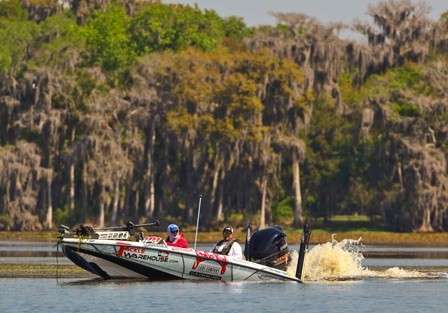
The life of an Elite Series pro isn’t all glamour and great fisheries. There’s travel, unpredictable weather and fishing tackle … lots and lots of fishing tackle.
So much fishing tackle, in fact, that keeping up with it is its own part-time job. Mark Menendez knows this well. After chasing bass all over North America, he’s learned that staying organized is a big part of being successful.
His take on tackle storage and organization can help us all.
“Bass fishing today is so different from when I got started,” Menendez says. “Back then we all carried big tackleboxes with all the gear we needed for a trip. Today, our boat is our tacklebox and we have millions of Plano boxes everywhere with all kinds of lures and gear in them. It’s a different approach, but a good one, if you stay on top of it.”
1. You can’t judge a book by its cover, but you can tell a box by its label
Part of staying on top of his burgeoning tackle demands involves one of Menendez’s new sponsors, Line-Rite. They manufacture a tagging system that helps Menendez be efficient and organized on and off the water.
“I use the rod tags to identify the line type and size I’m using with each combo,” he says. “They’re color-coded and tell you at a glance what type and size of line you’re using. When you carry multiple outfits, that can be nearly impossible to remember, and in a tournament it can cost you money. I’ll never forget tying a jig on what I thought was 20-pound line but turned out to be 12. I flipped it into a bush and wound up breaking off a really good fish. Of course, if I had been paying closer attention, I would have realized the mistake, but you get caught up in the excitement of fishing sometimes and miss those details. The Line-Rite rod tags are a big help.”
The company’s tackle tags are colorful labels for your utility boxes. They show you at a glance whether a box holds crankbaits or jerkbaits or topwaters — without peering through the lid to see what’s there.
2. Keep your “tacklebox” balanced
If your boat is your tacklebox, not only do you need to know where everything is located so you can find it at a moment’s notice, you also need to balance your gear for optimal flotation and the best ride possible.
“Generally speaking,” Menendez says, “that means putting your heavier gear in the back and the lighter stuff up front and putting as much of it as possible along the centerline. I like to keep my soft plastics, hooks and sinkers in the back and my hard baits up front. I generally get a better ride that way.”
3. Stay on top of things
“I have a habit of cleaning out my boat at the end of each fishing day and putting everything in a big Ziploc® bag,” Menendez says. “Hooks, torn up worms, baits I used throughout the day — everything goes in there. The problem comes in not returning the items to where they belong right away. I couldn’t find individual baits I wanted because they were in bags somewhere in the back of my truck rather than where they needed to be.”
The remedy for Menendez’s problem was to be more disciplined about staying organized. Now, at the end of each day — or almost every day, as he admits — is to put key items in the Plano boxes or plastic bags or other containers where they belong and where he can find them again at a moment’s notice, not after a 20-minute search of his Skeeter and tow vehicle.
“It takes discipline to stay on top of the system, but it really does pay off.”
Originally published November 2011.





